Top News
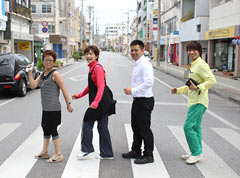
July 17, 2013 Ryukyu Shimpo
The Nago Avenue Association turned Nago Avenue into a transit mall limiting car traffic on July 21. They held various events providing food, music and relaxation. The association plans to hold such events once every two months. Its head, Hitoshi Urasaki, said, “We want to continue these events and to attract regular customers.”
The mall was about 300 meters long, running from the Nago Crossroads to the Hinpun banyan tree. Nago Avenue and the places around it become a transit mall every year at the time of the cherry festival, but this is the first time the avenue has become a transit mall on a regular basis.
People enjoyed music such as soul and jazz and eating local foods. Making smoothies and listening to soothing harp performances under the banyan tree were also popular. The association also plans to set up equipment for children.
The completion of a large commercial building has contributed to an increasing number of vacant stores in the avenue. The association ceased to meet temporarily until young business operators got it going again in 2007. Urasaki said, “Families can enjoy these events. I want lots of people to come along.”
Naoko Tamaki, who belongs to the NPO HiCO, which promotes city planning with the association members, said, “We do not want them to be one-off events.” She went on to say, “We want the city to flourish by attracting people in after the events.”
The association turned the avenue into a transit mall from 4:00 to 9:00 p.m. on July 21. They plan to hold more events on September 29, November 24 and January 25.
(English translation by T&CT, Mark Ealey)
Go to Japanese
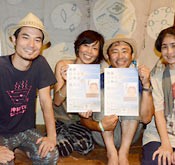
July 5, 2013 Ryukyu Shimpo
Four Yomitan residents have launched a new organization called “Yomitan Re: Peace Ranger.” It provides the opportunity for casual discussion of the constitution, peace and war.
As their first project, they are going to screen the movie “Nihonkoku kenpo the movie” at Yomitan Cultural Center Chu Hall on July 20. Takiro Kinjo who took the initiative to set up the organization, said, “We want to try change our society in which people feel uncomfortable talking about peace and the U.S. military base issue.” He went on to say, “Instead of forcing our way of thinking on others, we just want to provide the opportunity for young people and ordinary members of society to discuss these issues in a casual manner.”
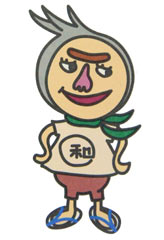
Yomihira Mamoru Kun
Kinjo, who runs a restaurant in Yomitan, feels that something is wrong with the way that people avoid discussing constitution and politics. Some say that discussing these topics is too serious and daunting. He feels uneasy because recently the media have been discussing amendments to the Constitution.
Company employee Ken Mimura joined the organization, saying, “We want to plan events that younger people can easily take part in.” His wife Yuriko created the mascot character Yomihira Mamoru Kun. Mika Yamaguchi said, “People can participate in events that suit them and there should be all sorts of options within the peace movement.”
In the organization’s name, “Re: Peace” means recreating peace. They plan to hold events that young people will be able to easily take part in, such as films and book reading. The organization now wants to attract “rangers” who agree with its purpose no matter where they live.
On July 20, they will set up a booth introducing books that explain the Constitution in easily understandable terms. The door opens at 6:30 p.m. and the movie starts at 7:00 p.m. The admission fee is 900 yen, but people aged 18 or under enter for free. Because of the nature of the venue advance reservations are required.
For reservation and enquiries, call the organizer at 090 (4779) 1080.
(English translation by T&CT, Hitomi Shinzato and Mark Ealey)
Go to Japanese

July 10, 2013 Yuki Nakasone of Ryukyu Shimpo
The Senkaku Islands and Liancourt Rocks disputes have been attracting international attention. Japanese, South Korean and Taiwanese researchers have launched a project to create common teaching materials on the topic of maritime territorial disputes. The materials are for junior high school students. The researchers propose that we look at national borders from the viewpoint of ordinary citizens and their livelihoods. The project aims to encourage the younger generation to share an understanding of history with their counterparts in these countries and districts by using the teaching materials in schools. Peaceful coexistence is the goal.
The researchers started lectures for college and university students this March in which they considered shared teaching materials. Taking on board ideas from the students, the researchers have tried to overcome differences of opinions across borders.
University of the Ryukyus Associate Professor Takeshi Yamaguchi, Konkuk University Associate Professor Park Sam Hun and Southern Taiwan University of Technology Associate Professor Yang Su-hsia are working on the project. They want to expand it in future to also reflect the Chinese standpoint.
The researchers deliver lectures for college and university students in the three countries and districts. They explain the different ways that textbooks in these countries and districts describe the territorial disputes and how the people react to “territory inherent to” their countries and districts. They reiterate the importance of discussing issues as global citizens who think beyond national borders.
Some students in the countries and districts involved suggested that ongoing exchange and discussion is important in order to resolve disputes. Others said that people in each of the countries and districts should try to reach agreement after they sufficiently understand each other’s position based on historical and objective judgment. Some said the governments should assert their ownership more strongly.
The researchers held an open study session at Okinawa Christian University on June 26 in which they introduced the content of the lectures and reported upon their research results.
Yang said, “Taiwanese people cannot understand the reality of the dispute just from their textbooks. Their government and media influence how people perceive the Senkaku Islands issue.”
Park stressed the importance of discussion across borders, saying, “Politicians in crisis use territorial disputes to manipulate us citizens.”
Yamaguchi said, “From junior high school age, children should learn how people view history and territory contributes to peaceful coexistence and learn how to settle disputes.”
The Asia Peace and History Research Institute of South Korea supports the project with assistance from the Northeast Asian History Foundation.
(English translation by T&CT, Mark Ealey)
Go to Japanese
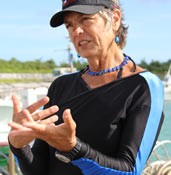
July 5, 2013
Oceanographer Katherine Muzik, formerly a professor at Harvard University, conducted an underwater survey at Oura Bay and offshore at Henoko, Nago on July 4. The U.S. military plans to build an alternative facility for Futenma Air Station in this area. She asserted the importance of Oura Bay and the sea off Henoko. Muzik said that it will be impossible to restore coral once the land reclamation destroys the reef. She added that this is the last chance we have to protect the coral.
Muzik lived in Okinawa for 11 years. In 1983, she called for the protection of the coral reefs at Shiraho in Ishigaki Island where the Okinawa Prefectural Government had planned to build a new airport.
In the survey carried out on July 4, she identified Porites tenuis and seaweeds off Henoko. Muzik said that while opposing the plan is not easy, each and every person should voice their objection so the coral reefs can continue to thrive. Muzik, who currently lives in Hawaii, stayed in Okinawa on this occasion until July 12, planning to visit Takae in Higashi Village and Futenma Air Station. She also gave a lecture at Nago City Central Library at 3:00 p.m. on July 6 and at the Prefectural Museum at 4:00 p.m. on July 7.
(English translation by T&CT, Megumi Chibana and Mark Ealey)
Go to Japanese
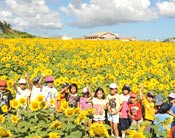
July 11, 2013 Ryukyu Shimpo
About 25,000 sunflowers now as high as two meters are in full bloom in a 1,980 square-meter field in Miyahira, Haebaru. Local resident Shinsuke Arakaki owns the field.
Haebaru Town and the Town Tourist Association celebrated the sunflowers on July 10, but the flowers will still be at their best until about July 20.
Deputy mayor Shinsho Kuniyoshi, 119 pupils of Haebaru Elementary School and the mascot character for the town, Haerun, enjoyed walking around the field.
Arakaki grows the sunflowers as green manure for his pumpkin field.

The Haebaru Agricultural Youth Club and the school’s pupils helped Arakaki to plant seeds this May.
Nine-year-old Yuka Tou said, “I learned from Mr. Arakaki that he grows sunflowers to help prepare the soil for growing pumpkins.” Arakaki said, “I am glad that the children enjoyed themselves.”
Contact Haebaru Tourist Association at 098 (851) 7273 for more details.
(English translation by T&CT, Mark Ealey)
Go to Japanese

Go To Video
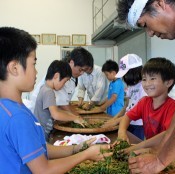
July 10, 2013 Ryukyu Shimpo
Eleven pupils of Nago City Inada Elementary School picked tea in the tea garden at Goga on July 5.
Staff of the Tea Producers Association of the JA Okinawa showed the pupils what to do. The children enjoyed making tea using traditional methods and hoped that it would taste nice. The association organizes for them to pick tea each year to help let local children know about the tea of the area.
The tea the pupils picked is a brand named Meiroku that has a reputation for good taste and bright color. The pupils made the tea by repeatedly kneading the leaves and roasting them in a cauldron.
Sixty-two-year-old Hidefumi Sakihama, who helped the pupils, said, “The tea will taste good if you knead the leaves with your palms.” Eight-year-old Daito Matsukawa, who worked on kneading the leaves, said, “The leaves were sticky at the beginning, but after a while they became crunchy.” Eight-year-old Yukina Takeuchi said, “I am a bit tired of kneading, but the leaves gradually came to smell good.”
(English translation by T&CT, Mark Ealey)
Go to Japanese
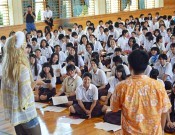
July 10, 2013 Ryukyu Shimpo
Chubu Agricultural High School in Taba, Uruma invited people from sexual minorities to deliver a special class on July 9. By meeting 22 such people, their family members and friends, the students were introduced to different ways of life and forms of sexuality.
This is the first time that an Okinawan school has invited a large number of people from same-sex relationships to hold such a study and exchange session. Based on their experiences, people aged 16 to 80 years old talked about their fear of discrimination. They said that they want people to acknowledge their existence even though it may be hard for them to understand.
A health and physical education teacher at the school, Fujino Machida, committed herself to holding the class. The school’s students all listened to the lecture in the gymnasium and took part in the question and answer session in each class.
A male in his 20s who addressed the school, said, “My heart is that of a boy, and I am attracted to males.” The man commented that there is hatred and misunderstandings towards sexual minorities. He said, “It’s the same as loving someone of the opposite sex. Fundamentally love exists in the same way.”
He introduced a friend, to whom he had confessed to be gay. He said, “If your friends come out to you, it means they trust you.” He went on to say, “If gay people come out, even though you may not be able to understand homosexuality, I want you to acknowledge the way they are.” He said, “Sexual minorities account for five percent of the population. That’s one in 20 people. This means that each class is likely to have one or two gay people.” He continued, “Some will even commit suicide because they become depressed about the difference in their sexuality.”
Sixteen-year-old Yuichiro Oshiro said, “I have never met people from sexual minorities before, but now I sense that there are more gay people than I had imagined. I enjoyed learning about this.”
(English translation by T&CT, Mark Ealey)
Go to Japanese

July 7, 2013 Sadaharu Shimabukuro of Ryukyu Shimpo
Three thousand employees of JFE Engineering have begun wearing kariyushi shirts in the company’s offices from July. Twelve branches nationwide from Hokkaido to Kyushu, including the main office at Yokohama in Kanagawa Prefecture, and 12 other companies in the group are using the shirts. In order to save energy and improve efficiency, this April the company ordered about 10,000 shirts from Okinawan companies.
The Okinawa Clothing Sewing and Manufacturing Industrial Association said that they had never received such a large order. The association expects that further orders from energy-conscious companies will allow them to expand their business to outside Okinawa.
According to JFE, at a get-together for board members and younger employees, the employees suggested that “Kariyushi shirts are functional and allow the wearer to express their individuality.” They added that it is Okinawan formal dress in summer. With this the company adopted the idea. Chief of Public Relations Masaya Hirotsune suggested that in the wake of the Great East Japan Earthquake, companies need to work on conserving energy, including electricity. He said, “Unlike the polo shirts of Cool Biz, many people see the kariyushi as formal wear and suitable for a business setting.” He also said that employees have been enjoying wearing kariyushi.
The general manager of the manufacturer’s association Isao Iraha said, “Using kariyushi shirts lets the public know that companies are concerned about environmental matters such as preventing global warming.” He went on to say, “I would like the use of Okinawan kariyushi shirts to become a model for protecting the global environment.”
(English translation by T&CT, Lima Tokumori and Mark Ealey)
Go to Japanese
July 19, 2013 Ryukyu Shimpo
Tokyo-based Toyo Keizai magazine announced their annual ranking of the Japan’s most livable cities for 2013. In Okinawa, Tomigusuku came 1st followed by Uruma and Nago. The previous year Nago came 2nd ahead of Uruma.
In the national rankings, Tomigusuku recorded the highest growth rate in the past five years based on other indices including population. The city has now come 1st four times in 2006, 2010, 2012 and 2013. It has topped the list for three consecutive periods except for 2011 when the magazine did not carry out the survey.
In the category of how reassured people can be, a rating based on the number of registered bed spaces and nursing home capacity, Nago came 9th in the national rankings. Tomigusuku was 11th followed by Itoman (16th).
The magazine focused on 789 cities nationwide and the wards of Tokyo. Based on official statistics it graded them according to 14 indices in the categories of how reassured people can be, levels of convenience and comfort, levels of wealth and housing satisfaction. The magazine carried out a comprehensive evaluation of the average scores.
It evaluated the growth rate of the cities based on 11 indices such as population and the number of companies operating in the past five years. In addition to Tomigusuku, four cities in Okinawa ranked in the top 20 in that category. Ginowan came 5th followed by Uruma (7th), Urasoe (11th) and Itoman (15th).
In the general rankings, Ienzai in Chiba Prefecture came 1st followed by Nonoshi in Ishikawa Prefecture and Moritani in Ibaraki Prefecture.
Although none of the cities in Okinawa ranked in the top 50 in the general ranking, Tomigusuku came 15th in the Kyushu-Okinawa region. Tomigusuku Mayor Haruki Gibo said, “Residents and local officials will work together to make Tomigusuku Japan’s most livable city.”
(English translation by T&CT, Mark Ealey)
Go to Japanese

July 9, 2013 Ryukyu Shimpo
A noguchigera, or Okinawa woodpecker, a species designated as a special national treasure, has recovered from injuries suffered in a road accident. It was released in Jashiki, Kunigami, about six kilometers off the road on July 8.
This is the first time that a noguchigera has returned to the forest after recovering from such injuries.
Seven accidents involving these birds have occurred since statistics began to be taken in 2009. The accident in question was the first this year.
The male noguchigera taken into care was an adult bird about 30 centimeters long and weighing 140 grams.
The person who found the injured bird lying on a road on June 30 reported it to the Yambaru Wildlife Conservation Center then the NPO Animal Hospital Okinawa took care of the bird. Because of its injured right leg, the bruises all over its body and where the bird was found, hospital staff judged the bird to have been hit by a car.
Ichihito Yamamoto, a conservation ranger at the Yambaru Wildlife Conservation Center said, “In addition to the Yambaru kuina, precious species such as the noguchigera and the Ryukyu long-haired rat have also been hit by cars.”
He appealed to people to drive slower and be more careful.
(English translation by T&CT, Mark Ealey)
Go to Japanese
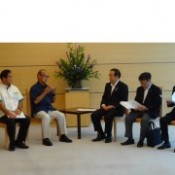
July 9, 2013 Ryukyu Shimpo
Okinawa Governor Hirokazu Nakaima and Ginowan Mayor Atsushi Sakima visited Chief Cabinet Secretary Yoshihide Suga at the office of the Prime Minister on July 9. They asked Suga to cancel the plan by which the U.S. military would station additional MV-22 Osprey aircraft to Okinawa in early August.
Nakaima mentioned the early return of the U.S. Marine Corps Air Station Futenma where the military plans to deploy the aircraft. He said, “The Okinawan people are still concerned about the danger posed by the Osprey.” Suga said, “We would like to work towards reducing the excessive burden on Okinawa of hosting the U.S. military bases,” but he did not mention canceling the plan.
After the meeting, Nakaima talked to the press, saying, “The former administration led by the Democratic Party of Japan responded to our requests relatively quickly, but the current administration hardly responds to our requests at all.” Nakaima will ask the central government to respond more swiftly.
Sakima said, “Stationing the Osprey to Futenma Air Station continues to concern local residents because of its location in a densely populated area. I want the central government to provide a specific plan to remove the danger involved.”
Nakaima and Sakima asked the central government to respond to six requests regarding the reduction of Okinawa’s burden. These include sending the aircraft to other prefectures and the U.S. military adhering to the agreement set up by the Japan-U.S. Joint Committee on the aircraft’s operation.
They also visited Defense Minister Itsunori Onodera in the afternoon of July 9.
(English translation by T&CT, Mark Ealey)
Go to Japanese













 Webcam(Kokusai Street)
Webcam(Kokusai Street)


